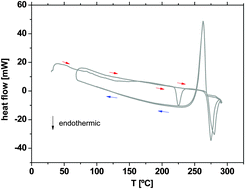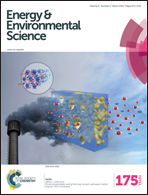Glass-amorphous alkali-ion solid electrolytes and their performance in symmetrical cells
Abstract
Precursors of the crystalline antiperovskites A3−xHxOCl (A = Li or Na and 0 < x < 1) can be rendered glass/amorphous solid Li+ or Na+ electrolytes by the addition of water to its solvation limit with/without the addition of a small amount of an oxide or hydroxide. The solvated water is evaporated as HCl and 2(OH)− = O2− + H2O. The O2− attracts a Li+ or Na+ to form dipoles; the remaining Li+ or Na+ are mobile. The Li+ or Na+ ionic conductivities of the glass/amorphous solids have activation energies ΔHm < 0.1 eV and a room-temperature conductivity comparable to that of the best organic liquid electrolytes. Measurements of the dielectric loss tangent versus frequency show two overlapping resonances at room temperature with the Ba-doped Li-glass; they are nearly overlapping at temperatures 41 °C < T < 141 °C in the Ba-doped Na-glass. Galvanostatic charging of a symmetric Cu/Na-glass/Cu cell for 1 h showed a remarkable self-charge on switching to open circuit; charging for 15 h followed by discharging at an applied −0.1 mA of the symmetric cell showed, in the discharge mode, a replating of sodium on the anode at a positive cell current of +0.07 mA for over 15 h. A model for these behaviors is proposed. A symmetric Li/Li-glass/Li cell was cycled to demonstrate plating of Li on a current collector from the Li-glass electrolyte.


 Please wait while we load your content...
Please wait while we load your content...